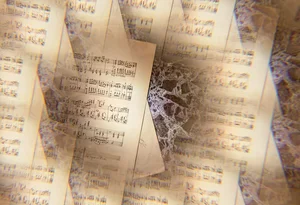Music from the mirror maze of the self
Melanie Unseld analyzes autobiographical music as a reflection of the self. Berlioz's Symphonie fantastique is not a true chronicle of love, but a stylized self-portrait. Music does not tell a story objectively, but subjectively—like a distorting mirror in the labyrinth of memory.
«In autobiographically colored compositions, the fundamental question arises as to whose life is being recounted here.»
Can music tell stories? Can melodies, sounds, and chords be put together in such a way that we can discern a concrete narrative from the music, with main and secondary characters, dramatic events, emotions, and descriptions of situations? Can music even tell a life story, a biography, or an autobiography?
Much ink and printer's ink has already been used to prove (or disprove) the narrative qualities of music, its ability to tell stories. It is clear that music differs from language in this respect, which is undoubtedly capable of telling stories in detail with semantic clarity. But music? What does the story of unrequited love sound like? Do we actually hear a dragon, a sword, a hero—or just Richard Wagner's leitmotifs? Not to mention Franz Liszt's symphonic poems, Richard Strauss's Thus Spoke Zarathustra, or Hector Berlioz's Symphonie fantastique. Composers do not concern themselves with the music-theoretical or music-philosophical question of whether music can be narrative. They set stories to music. At least, they occasionally write music that is intended to make a story comprehensible. And they compose music that tells the story of their own lives, autobiographical music.
Interestingly, memories of pleasant experiences rarely inspire compositions—Fanny Hensel's piano cycle Das Jahr (The Year) is one example, a ‹souvenir composition› of her trip to Italy. Much more often, it is not the ‹beautiful moments› of life that are set to music, but the dramas of life. Bedřich Smetana’s Piano Trio in G minor, Op. 15, for example, bears the inscription: «In memory of my first child, Bedřiška, who delighted us with her extraordinary musical talent, but was taken from us by the inexorable hand of death at the age of four and a half.» Even better known than this portrait of his daughter who died young is his string quartet From My Life, composed in 1876. Here, too, it is a traumatic experience that has found its way into the composition: the loss of his hearing. Alban Berg took a more secretive approach when he composed his passionate love for a married woman into his Lyric Suite. Unlike Smetana, he set out to keep the ‹program› of the Lyrical Suite, and thus his love, secret. No one but Hanna Fuchs-Robettin was to understand his passions and longings. In terms of composition, Berg used tone letters, among other things: B-F for the name Hanna Fuchs and A-B for his own. Incidentally, he gave the only annotated copy of the pocket score, in which he ‹decoded› his feelings, to his distant lover. Gustav Mahler called out to his beloved wife, who was moving away from him, in the score of his unfinished 10th Symphony: «Ach, Almschi!» Numerous traces can be found in the manuscript of this symphony, traces that point to the composer's unhappy life situation shortly before his death. The sheet music seemed to be a conversation partner for him, to whom he could confide his despair (knowing full well that his wife would read his notes and thus also his messages). And even if the music in this case does not ‹tell› the story of the confused love triangle between Gustav, Alma Mahler, and Walter Gropius, it is nevertheless autobiographical in another sense.
And Berlioz? Nothing less than the «drama of my life» was the starting point for his Symphonie fantastique. In his memoirs, Berlioz writes extensively about his relationship with Harriet Smithson. He begins this chapter dramatically with the words: «I now come to the greatest drama of my life. I will by no means recount all the painful events of it. I will limit myself to saying the following: an English theater company came to Paris to perform Shakespeare's plays [...]. I attended the first performance of Hamlet at the Odéon. In the role of Ophelia, I saw Harriet Smithson, who became my wife five years later.» There was no question of restraint in the treatment of the «drama». Berlioz's tumultuous emotions found expression in music, in the Symphonie fantastique. Let us listen to the story of this amour fou.
With autobiographically colored compositions, the fundamental question arises as to whose life is being told here. More pointedly: is the rhetorical ‹I› actually identical with the person who composed the work? So what does autobiographical music ‹tell› us: the composer’s own life or a self-portrait in themes of suffering and leitmotifs?
Autobiographical compositions are comparable to written memoirs and autobiographies that bring one's own life into the public eye. However, these are characterized by self-stylization. The writing self models the self that it is willing to reveal to the reading audience, the self that it wants to present to the outside world. The rhetorical self of the autobiography is thus, at best, a reflection of the writing self. And not infrequently, this mirror is a distorting mirror or even part of a complicated mirror maze from which we cannot easily find the exit. To paraphrase Sigmund Freud, one could say that autobiographical truth is fundamentally «unattainable», and even «if one had it, it would be of no use».
If autobiographical music is understood not as a reflection of lived experience, but as an acoustic mirror maze, then the assumption that the stories told in this way are ‹true›, i.e., ‹correspond to reality›, also becomes obsolete. Thus, Berlioz's Symphonie fantastique is not a chronicle of his relationship with Harriet Smithson. Rather, the composer gives himself the opportunity to transform the symphonic form with a fantastic program and to showcase himself with wild instrumental timbre experiments. The symphony thus becomes a hymn to Berlioz himself as an experimental, avant-garde composer.
Author: Melanie Unseld




